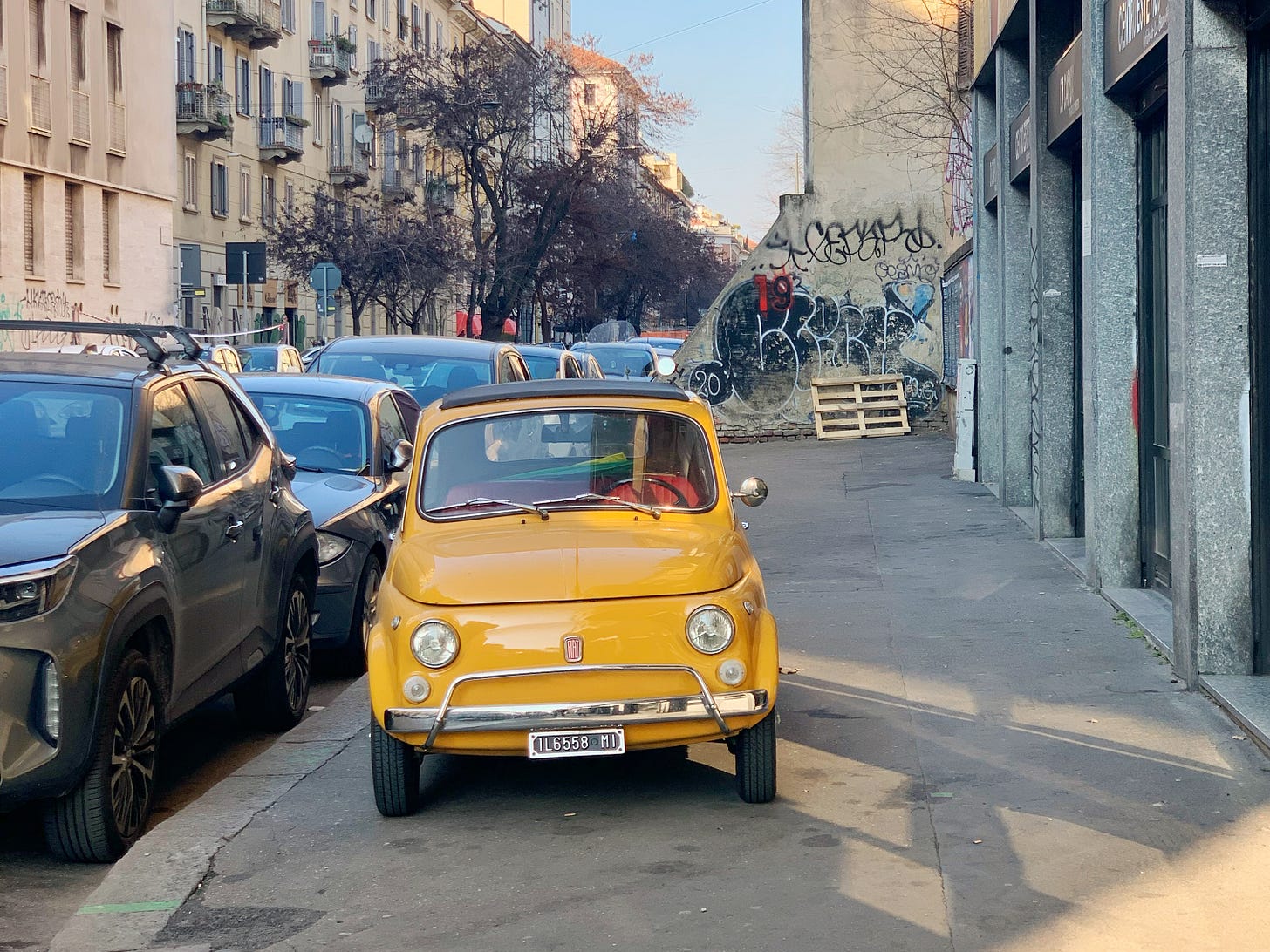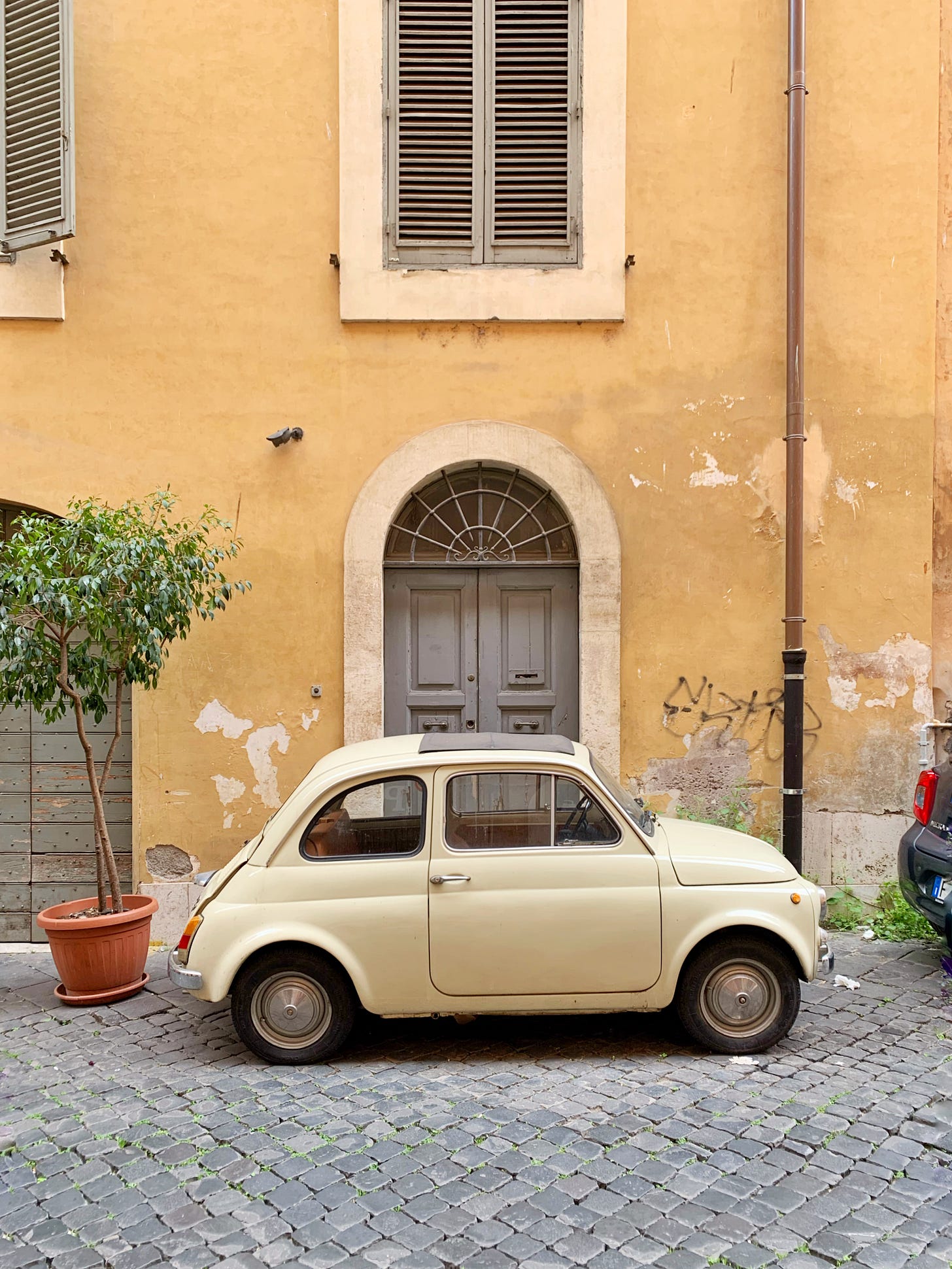I’ve been driving for nearly half of my life, but I can only describe driving in Italy as a rather, um... humbling experience. Luckily, I’ve never been in an accident or anything like that (knock on wood), but there are moments when it dawns on me that I’m taking my life in my hands here.
I’ve also made some stupid mistakes, like the time I unwittingly drove through Villa Borghese (the famous park in the heart of Rome) because I was so concentrated on following Google Maps that I didn’t notice the sign indicating that the street was restricted to taxis and buses. I wouldn’t recommend doing that.
Romans like to complain about the public transit here, but I much prefer taking the metro to trying to navigate this city, with all its restricted areas and chaotic traffic, by car. Plus, parking can be a bit of a challenge, to put it lightly.
That said, having a car can definitely give you the freedom to follow your own schedule—plus it’s the only way to reach some of the country’s more rural corners. But if you’re used to driving in North America—or just about anywhere else, really—there are some things to keep in mind.
Make sure to request an automatic car
If you want an automatic car, you definitely need to reserve one in advance. Most of the cars available at rental agencies have a stick shift—and if you don’t have experience with them you’re not gonna want to try and learn how to drive one up and down the hills of Tuscany. You will have to pay more for an automatic car, but just ask yourself: Is my sanity worth it? Hopefully your answer is yes.
Watch out for ZTL signs
ZTL stands for Zona a Traffico Limitato (Limited Traffic Zones). They are all over Italy, especially in historic districts, like much of the city center in Rome, but also in small towns. ZTLs are usually active for most of the day and may or may not be deactivated at night. When they’re active, only residents and permit-holders are allowed to drive on those streets. Violate them and you will get fined—and possibly yelled at by locals. Be prepared to park outside the historic districts and explore them on foot. Oh and definitely don’t drive through Villa Borghese.
Watch those corners
The narrow cobblestone streets flanked by historic buildings are oh so charming when you’re leisurely strolling, but try maneuvering a vehicle through those narrow lanes—which, by the way, are not necessarily one-way streets even if there’s just barely enough room for one car—and you’ll understand why Fiat 500s (or better yet, Vespas) are so popular here. And it’s not just in densely packed cities and historic towns where the streets are narrow. Even my Roman husband Marco, who can drive confidently pretty much anywhere, gets stressed driving the notorious Strada Statale Amalfitana 163 with its tight curves hugging the cliffs.
Be prepared for small cars
Speaking of Fiat 500s, cars in Europe tend to be smaller than those in the U.S., especially in Italy. Until recently, when we got a Toyota Corolla, Marco and I drove around in a tiny Volkswagen Lupo. He, of course, decided to install a new stereo in it, which took up about 90% of the trunk space, so we literally couldn’t fit more than a small backpack in there. When my family came here for our wedding, we somehow managed to stuff five people into that two-door tin can on wheels. I was squished in the back with my dad and my sister and it felt like we were in a clown car and the rear end was about to start dragging down the road.
Beware of speed traps
In all the years I’ve spent living and traveling in Italy, I have never seen a police officer pull anyone over for speeding. But before you get ahead of yourself, that doesn’t mean speeding goes unpunished. It just means that there are electronic speed traps on the roads. Sometimes they’re marked—sometimes not. When Marco suddenly hits the breaks for seemingly no reason, I know he spotted one. On the autostrade (major interregional highways) the maximum speed is usually 130 kph (about 80 mph). This isn’t the German autobahn after all—and even there only certain stretches are speed limit-free.
Good luck figuring out the rules of the road
Now, I don’t want to stereotype here, but let’s be real, Roman drivers are crazy. And Neapolitan drivers are even crazier. I drive a moderate amount here, but enough to expect that cars will dart out from side streets onto the main road, seemingly without giving heed. You might technically have the right of way, but what that looks like in theory and practice are two different things. My sister once described the experience of approaching a four-way intersection in Naples as “like playing a video game,” adding, “it was every car for itself.”
Watch your hand gestures
Before you raise your hand, make sure you know the meaning of the gesture you’re about to make. Italians are famous for expressing themselves non-verbally, but you’d better spend some time studying the gestures before using one yourself. While driving in Italy, my unsuspecting Israeli brother-in-law made a gesture that in Israel is meant to ask someone to wait. Little did he know that in Italy, that gesture means, “What the f***?!”
Parking is um... interesting
There are a lot of rules about where you can and can’t park in Italy. Parking spaces bordered by white lines are free. Blue lines mean you have to pay. Yellow lines are for disabled people or residents only. Then there are exceptions. Owners of electric or hybrid cars can park in the blue lines for free in the city where their car is registered. But if you really want to adapt to Italian culture, just park wherever you want—preferably on the sidewalk.
Who you gonna call?
If your car breaks down, you will have to call the carro attrezzi (i.e. tow truck). I learned that vocabulary from experience last fall. Just try not to break down while the mechanics are on their lunch break or you could be waiting a few hours. Oh and definitely don’t break down on a Sunday. Good luck to you if you do.
A Little Announcement
I’ve been trying to keep all the content in this newsletter free for as long as possible, but it takes quite a bit of time and energy to put it together, so starting on February 16, select issues will be put behind a paywall. If you upgrade your subscription by February 9, you’ll get 30% off using this link.
Further Reading
My Amalfi-based colleague
wrote about the history of the famed Strada Statale Amalfitana 163 in the latest issue of her Substack .If you dare to drive SS 163, you’d better read up on the driving restrictions put in place there last year. I wrote about the new alternate number plate system for AFAR.
This guide to Italian hand gestures by CNN is an oldie but a goodie.
This TripSavvy article has even more details about driving in Italy.
Don’t be an idiot like this guy, who was slapped with a €500 fine for driving across Florence’s Ponte Vecchio, according to Travel + Leisure.
Prefer to avoid driving all together? Check out this piece I wrote for The Points Guy about 6 cities you can easily visit on Italy’s high-speed trains.










great overview and I can confirm that finding parking in Rome is challenging! I drive a cinquecento that takes up as little space as possible but still feels safe enough for getting around.